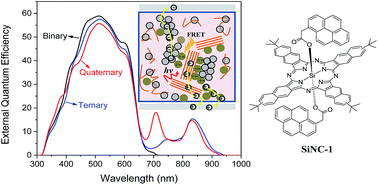Panchromatic ternary/quaternary polymer/fullerene BHJ solar cells based on novel silicon naphthalocyanine and silicon phthalocyanine dye sensitizers†
Abstract
More efficient light harvesting throughout the whole solar spectrum by introducing third and fourth components offers a new pathway towards the development of high efficiency organic solar cells based on polymer/fullerene blends. Recently, dye molecules have been utilized as promising light harvesting photosensitizers in the near-IR region. Herein, we report the design, synthesis and application of a novel silicon naphthalocyanine (SiNC-1) as an efficient photosensitizer in single dye ternary devices as well as in multi-colored co-sensitized quaternary devices, incorporating a silicon phthalocyanine (SiPC-0 or SiPC-1) as the fourth component to complement the spectral absorption of the SiNC-1. The dominant complex charge transfer/transport mechanism behind the enhanced photosensitivity of the ternary blend has been investigated by means of electrical, optical, and advanced characterization techniques. External quantum efficiency (EQE) measurements on multi-colored dye sensitized devices covering the UV-vis as well as near-IR regions from 350 up to 900 nm outline apparent signal characteristics of each single dye, corroborating the effective contribution of both SiPC and SiNC dyes to enhancing the short-circuit current density (JSC). Our results further illustrate the potential of the multi-colored dye sensitization concept as a powerful approach to mitigate the non-ideal optical absorption normally encountered in organic-based optoelectronic devices.



 Please wait while we load your content...
Please wait while we load your content...